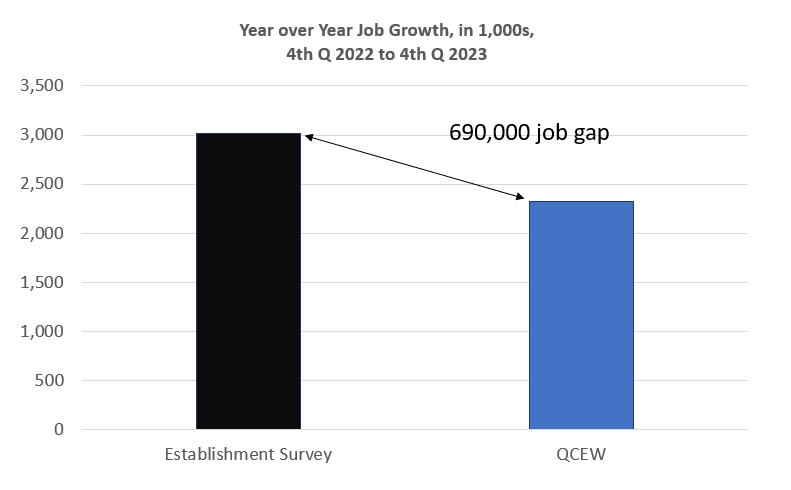Yesterday, we looked at how the Business Employment Dynamics (BED) report showed job losses last year while the much-reported and much-touted monthly Establishment survey report showed “blowout” job gains throughout most of the year. Indeed, over the past year, the Establishment survey has repeatedly showed considerably more job growth than both the BED report and the Household survey. Another source we can now consider is the Quarterly Census of Employment and Wages (QCEW), also released by the Burau of Labor Statistics. This report is prepared quarterly, rather than monthly. It provides far more detail than the Establishment report, and QCEW surveys nearly twenty times more businesses than the Establishment survey. The most recent QCEW report revisions show—not
Topics:
Ryan McMaken considers the following as important: 6b) Mises.org, Featured, newsletter
This could be interesting, too:
Nachrichten Ticker - www.finanzen.ch writes Die Performance der Kryptowährungen in KW 9: Das hat sich bei Bitcoin, Ether & Co. getan
Nachrichten Ticker - www.finanzen.ch writes Wer verbirgt sich hinter der Ethereum-Technologie?
Martin Hartmann writes Eine Analyse nach den Lehren von Milton Friedman
Marc Chandler writes March 2025 Monthly
Yesterday, we looked at how the Business Employment Dynamics (BED) report showed job losses last year while the much-reported and much-touted monthly Establishment survey report showed “blowout” job gains throughout most of the year.
Indeed, over the past year, the Establishment survey has repeatedly showed considerably more job growth than both the BED report and the Household survey.
Another source we can now consider is the Quarterly Census of Employment and Wages (QCEW), also released by the Burau of Labor Statistics. This report is prepared quarterly, rather than monthly. It provides far more detail than the Establishment report, and QCEW surveys nearly twenty times more businesses than the Establishment survey.
The most recent QCEW report revisions show—not surprisingly—job gains for 2023 totaling more than 690,000 below the Establishment survey. Put another way, the monthly Establishment numbers, pushed so heavily by the media and based on a much smaller sample, claim there are 690,000 jobs out there that probably don’t exist.
More specifically, the QCEW estimates there were 154,848,000 jobs in the US economy at the end of 2023. That’s an annual gain of about 2,322,000.
The Establishment Survey’s most recent revisions, on the other hand, claimed there were 157,304,000 jobs at the end of 2023. That’s an annual gain of 3,013,000 jobs.

In other words, the Establishment survey showed nearly 30 percent more jobs created in 2023, compared to the QCEW. One should also note that the Establishment survey numbers used here are post-revision numbers. In most months of 2023, the Establishment survey’s job growth numbers were revised down many weeks after their initial release. That meant that the media would report on inflated estimates—touting them as evidence of a historically robust economy—when those numbers would usually end up being revised downward later. The media, of course, rarely reports on the revised numbers. Now we find that even the revised numbers likely overestimate the actual job-growth situation.
Tags: Featured,newsletter
